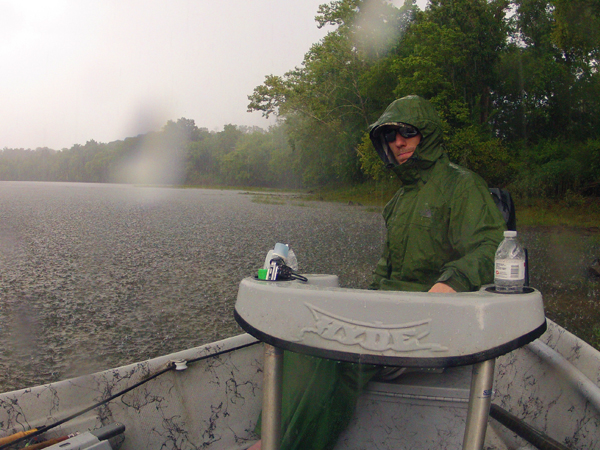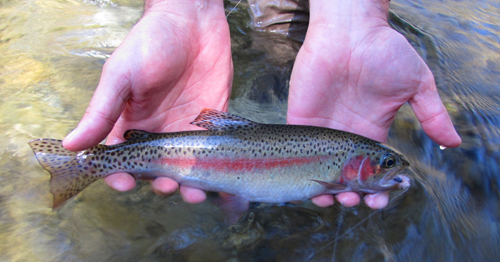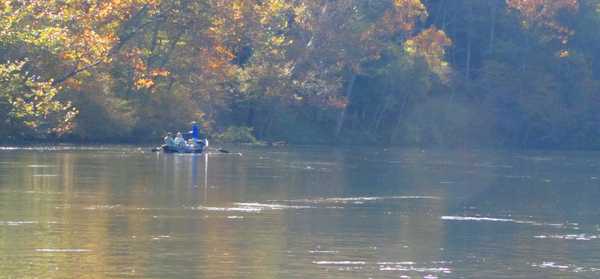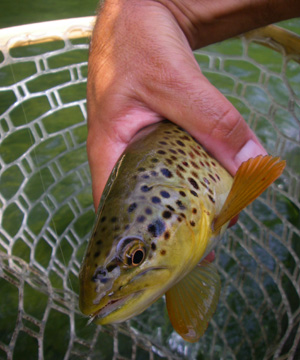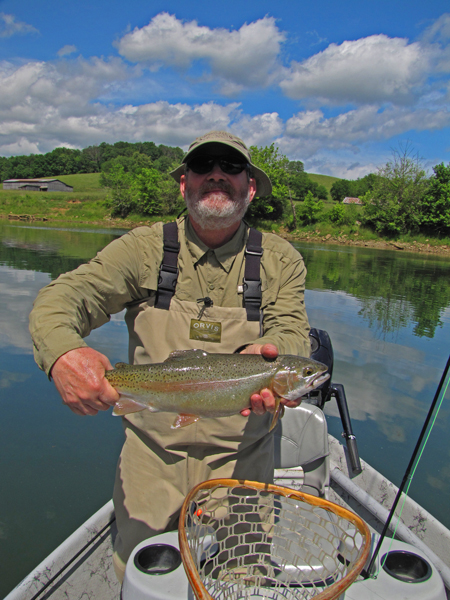We hear it all the time. “How does (insert weather condition) affect the fishing?” At the moment we’re pushing a 14″ surplus for rainfall and the year isn’t even half way through yet. So, as you might imagine, we’re getting tons of questions about how all this water influences fishing and fish populations.
In the past 20 years we’ve experienced two or three of the highest flows ever recorded in East Tennessee as well as the lowest. We’ve been around the block but it seems like we’ve lived several lifetimes when it comes to extremes in river conditions here in East Tennessee. In 1994 and again in 2003 we saw record flows that changed many features on our local streams. If you’re familiar with Townsend, in 1994 and 2003 Little River was even up over Highway 321 on the lower end of town by The Back Porch restaurant at the intersection of 321 and Old Tuckaleechee. In 2007 and on into 2008 it seemed as if our streams had all but dried up and we endured not only a dry year but an unusually hot one as well.
This year we are seeing record flows, but not all time record breaking high flows. We’re seeing daily flow records regularly set. This is just same way a 40 degree morning would be a record in July but commonplace in March. The flows we’re seeing are normal in the spring just unusual for summer. Furthermore, we’re used to seeing the river get this high as times in the summer, just not for days on end. Thunderstorms will regularly cause flows to spike but the constant string of wet weather we’re seeing is keeping these flows unusually high for an unusually long time for the summer months.
We have some insight into what this exceptionally wet season has in store for fly fishers across East Tennessee. First of all it’s important to realize one thing. Fish like water! These up and down conditions can make it tough to fish, but in the end it’s not a bad thing for the fish. Another thing to realize is that with all the diversity we have among mountain streams and tailwaters, there will be different effects depending on the river.
Mountain Streams
Fishing in the mountains has been up and down all season just like the flows. However, it’s important to realize that the fish have been VERY happy. Last week we took a family for an afternoon of fishing because flows were too high in the morning. They were even higher than we would have liked in the afternoon but the father literally begged us to do something even if it was only a lesson as a day of fly fishing was the focal point of their whole trip.
There were a few fishable spots even as the bulk of the water was too high for safe or effective fishing. In the few spots where we able to safely cast the fish were all over the fly. It was a far more successful afternoon than we had expected.
The fish are built for it and there are plenty of places for them to live comfortabley even if we’re not able to effectively fish for them. The biggest plus for the fish is that the water temperatures in the Smokies are the coolest we can ever remember in the summer, often staying in the upper 50’s for several days at a time. This keeps the trout’s metabolism lower and allows them to grow better. Typical summer temperatures are usually a limiting factor in how big Smoky Mountain trout can get as there will be several weeks when their metabolism will be running faster than the amount of food they can eat.
Many of the larger streams can get pretty high with the extra water but don’t always expect headwater streams to be better. Headwater streams in the Smokies are very steep and high water means lots of whitewater. Even though these streams are smaller they can be more dangerous than big, long pools with a gravel bottom. Trust us, a slip on a small stream with high water can result in a scary round of body surfing.
Because of high flows from last winter and on into the spring we may not see any reproduction from the trout this year as eggs or sac fry may have been washed out. This sounds bad, but is actually a good thing for the long term. This means we’ll have a few less trout but that also means that fewer trout will have more space and food for themselves. The end result is larger trout. We’ve seen this in the past after previous flood years and it’s a positive effect that lasts much longer the the short term tough conditions.
Tailwaters
The biggest problem for fly fishers on the tailwaters is primarily one thing: high flows. Most anglers wade these rivers and the flows are simply non-negotiable for wading. Those who have boats will find more opportunity but still have to pay attention. All of our tailwaters are different from the others so each must be treated on its own terms. Here’s what to look for:
Clinch River – The Clinch has had some very good flows for waders due to a construction project on the weir dam. However, this has caused Norris Lake to get higher than it would have if TVA ran the dam the way they would have without this project. Now that the lake is well above full and inflows are heavy they are forced to generate a full two generators for days on end. This is not an ideal flow for fishing but strong Sulphur hatches have actually had fish up rising in a few spots in the afternoon. This isn’t a sure thing, though. Those who insist on floating with two generators should pack some big streamers and a sink tip fly line with a fly rod no smaller than a six weight. This type of fishing is not about quantity but quality. You might only turn two fish all day, but they might be the biggest you’ve ever seen.
South Holston – Flows on the South Holston are actually pretty close to what we see every year and fly fishers are typically used to wading conditions that only last for the morning. Afternoon flows are usually high but ideal for floating. Strong storms can create muddy conditions though as a tributary near the Emmet Road bridge will pump dirty water into the river. There are more down the river so it can get filthy but the time the river is down around Weaver Pike.
Watauga – This is usually the most reliable river around in terms of flows but there have been some high flows this summer. It’s been up and down this year as Watauga Lake has seen record high levels. Dirty water is a major concern here as a number of tributaries such as Stoney Creek and Doe River can pump in some mud.
Hiwassee – Most fly fishers end up abandoning the Hiwassee in summer because of flows that are too high to wade. This summer is certainly no different, although high flows are typically good for the fish in this river and those with some skills on a set of oars can do very well here. Low flows on the Hiwassee cause a rise in water temperatures that are awful for the fish. This year looks like good flows should keep the trout healthy and spread out across the river. Low water years will see fish congregate to certain areas that remain deep with zero generation.
Holston River – The Holston River below Cherokee Dam has perhaps the most complex set of issues when it comes to a wet season. This is really a big river and even with a boat it’s tough to fish effectively with any generation. It probably would be a good float with one generator, but that’s not a condition we ever see as TVA generally cranks this river up to 9,000 cfs or more, often in excess of 15,000 cfs. The river is most fishable around 400 cfs so you get a sense of the shift in scale. With the river generating so much we’ve had very few opportunities to fish here this year, although the fish have been in exceptional health. Unfortunately, it’s not so simple.
Cherokee Lake is deep enough to maintain cold water, but not so deep to have an unlimited supply of it. Cold water stored up from the winter and spring may flush out and be replaced with warmer water as the season progresses. Water temperatures here are in the high 50’s or low 60’s right now which is a little higher than what we usually see in June. This may not be a big problem if generation abates a bit and we don’t have a major heat wave.
Problems will arise when water temperatures are coming from the dam in the mid to high 60’s with low flows and air temperatures in the 90’s. It doesn’t take much to get the water to rise quickly under these circumstances. This is a possibility but not a certainty, but we’re understandably nervous.
